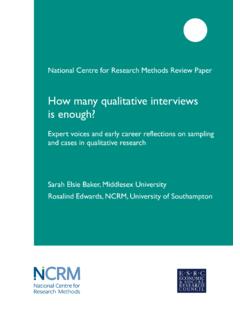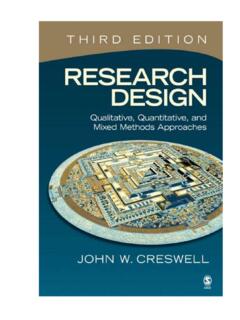Transcription of Doing a Literature Review in Health - SAGE Publications Inc
1 Doing a Literature Reviewin Health1 KATHRYN JONESINTRODUCTIONThe Literature Review aims to identify, analyze, assess and interpret abody of knowledge related to a particular topic and is normally requiredas part of a dissertation or thesis . In this case, it sets a context for aresearch study and provides a rationale for addressing a particularresearch question in the light of an existing body of Literature . Researchproposals to funding bodies also typically include a Literature the purpose is to justify the proposal in terms of a gap in existingknowledge.
2 Some Literature reviews are substantive, stand-alone studiesin their own right that serve to assess what is known and what is notknown on an area of study. The aim in both cases is to show how aparticular topic has been approached by other scholars. Within thehealth field, the Literature Review can also aim to assess existing knowl-edge on the efficacy of an intervention such as the evidence base for thepreferred treatment of a particular disease or the response to a 1/12/2007 8:31 PM Page 32 Doing a Literature Review in Health33 This chapter describes how to undertake a rigorous and thorough Review ofthe Literature and is divided into three sections.
3 The first section examines thetwo main types of Review : the narrative and the systematic Review . The secondsection describes some techniques for undertaking a comprehensive search,while the third gives guidance on how an analysis of the Literature can bepresented. It is assumed in the chapter that those undertaking a Review willhave access to college or university library resources and to the Internet. Themajority of sources can now be accessed electronically. Those who have notpreviously searched using an online catalogue or database are advised to seekassistance prior to starting out.
4 Most college and university libraries offercourses, publish guidelines or make help available the chapter, examples are drawn from recent studies undertakenby the author and OF Literature REVIEWAll reviews aim to provide an overview of what is known about a particular phe-nomenon and what the gaps in knowledge are. However, narrative reviews, whichare used widely in social scientific research, place an emphasis on identifying thekey concepts or specific terms used in the Literature and the particular theoreticalapproaches adopted by different authors to understanding a and theories may be employed implicitly or explicitly in an investigationof a topic.
5 A Review of the Literature will identify the range of approaches and offera critique of their contribution to systematic Review of the Literature in Health and social care has a differ-ent focus. It aims to contribute to clinical practice through an assessment of theefficacy of a particular Health care intervention and, with the emphasis onevidence-based practice, has become increasingly important. A basic overviewis given here but the researcher should seek advice from a trained informationspecialist prior to undertaking a search. Specialized statistical skills are alsonecessary (see Egger et al.)
6 2001).The narrative reviewThe narrative Review is the commonest form of Literature Review . It aims toshow how concepts, theories and methods have developed within particularsubject areas. The key differences between concepts, theories and methods are: Concepts: Terms and ideas used to describe a particular phenomenon. Theories: Ideas that have been developed to explain a specific phenomenon. Empirical research: Research that has already been undertaken to observe 1/12/2007 8:31 PM Page 33 Methodology: The philosophical approach adopted by a researcher to study aparticular phenomenon and not to be confused with methods.
7 Methods: Techniques such as questionnaires, observation or interviewing used tocollect a narrative Review the reviewer offers a critique in order to assess, analyzeand synthesize previous research, and place it in its current context. The reviewcan take a number of forms: a chapter within a dissertation showing the con-text of the research; a section of a proposal justifying the work; or a stand-alonesummation of thinking around a particular subject area. In each, the reviewerdraws on and critiques the conceptual and theoretical approach of differentauthors and offers an assessment and reading the item concerned, the reviewer seeks to identify the partic-ular conceptual and theoretical approach taken by the author.
8 This is likely tobe influenced by the author s background and discipline. So, for example, apolitical scientist interested in public involvement in Health policy making islikely to draw on theories relating to interest groups in the policy process, par-ticipation and representation. A sociologist of Health and illness writing on thesame topic might place their work in the context of people s experience of ill-ness and how this may affect their wish to participate in decisions and policymaking. Identifying the conceptual and theoretical approaches taken by differ-ent authors is the first step to understanding the Literature and, in the writingup stage, will influence the structure of the report, another vital component ofthe narrative Review as will be seen systematic reviewOver the past few decades, evidence-based practice has achieved growing recog-nition as a means of increasing the efficacy of Health care interventions.
9 Initiativessuch as the international Cochrane Collaboration(see Chapter 19 for a fuller descrip-tion) and organizations such as the National Institute for Health and ClinicalExcellencein the United Kingdom assess available evidence to inform guidelines,policy and practice. A systematic Review enables the reader to appraise criticallythe most robust evidence available in an attempt to synthesize what is known, andnot known, about the efficacy of particular interventions. According to Petticrew(2001), systematic reviews can be characterized by the following criteria: They aim to answer a particular question or test a hypothesis usually in relationto a particular Health care intervention on a particular population group.
10 They attempt to be as exhaustive as possible, identifying all known references. Studies included in the Review are chosen as a result of explicit inclusion and exclu-sion criteria. The assessment of the evidence and the synthesis of results are basedon the thoroughness of a study s research Health Research34 Saks-3519-ch 1/12/2007 8:31 PM Page 34 Systematic reviews place an emphasis on judging the quality of evidence. Here,the priority is to utilize studies where the research design minimizes bias ashighlighted by the list below showing the traditional hierarchy of evidence forreviews assessing the effectiveness of a particular intervention.














